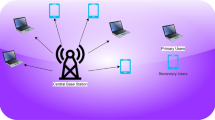Abstract
In our proposed system, the vehicular sensor network is formulated based on the cognitive radio with the aid of optimal tree routing protocol. Tree routing protocol for cognitive radio network effectively coordinates between tree routing module and channel assignment module. Here the traditional routing protocol is modified by means of optimization technique. In our proposed method the root channel is optimally selected using artificial fish swarm algorithm. Based on that effective root channel is selected for transmission and the other channels are switched to disabled state. So that MCTRP routing protocol to efficiently manage spectrum allocation that helps reduce the routing delay and rank the channels available from end to end. And also our proposed routing protocol is efficiently deal with frequent link failure. The performance of the proposed technique is evaluated by packet delivery ratio, throughput, overhead, delay, drop, and channel utilization. The proposed technique is implemented in the working platform of NS2. Our proposed method has better channel utilization capacity of 86.6% then the existing CTRP and OLSR method. From the experimental result, it is clear that our proposed method has low delay, high delivery ratio, low packet drop and maximum throughput, minimum overhead and maximum channel utilization value when compared to the existing CTRP and OLSR method.










Similar content being viewed by others
References
Jalil Piran, M., Cho, Y., Yun, J., Ali, A., & Suh, D. Y. (2014). Cognitive radio-based vehicular ad hoc and sensor networks. International Journal of Distributed Sensor Networks,10(8), 1–11.
Nassef, L., & Alhebshi, R. (2016). Secure spectrum sensing in cognitive radio sensor networks: Secure Spectrum Sensing In Cognitive Radio Sensor Networks: A Survey, 6(03), 1–7.
Patel, J., & Thakkar, M. (2013). A survey on cognitive radio wireless sensor networks.1, 146–148
Abolarinwa, J. A., & Achonu, A. (2013). Cognitive radio-based wireless sensor networks as next generation sensor network: Concept, problems and prospects,4(8), 146–148.
Qu, Y., Dong, C., Tang, S., Chen, C., Dai, H., Wang, H., et al. (2017). Opportunistic network coding for secondary users in cognitive radio networks. Ad Hoc Networks,56, 186–201.
Rao, K. L., Chakravarthy, C. K., & Chilukuri, S. (2015). Energy efficient routing in cognitive radio networks: Challenges and existing solutions. Journal on Communication Technology: Special Issue.,6, 1039–1052.
Mishra, P., & Dewangan, N. (2015). Survey on optimization methods for spectrum sensing in Cognitive radio networks. International Journal of New Technology,1(6), 23–28.
Wang, J., Chen, R., Tsai, J. J. P., & Wang, D.-C. (2018). Trust-based mechanism design for cooperative spectrum sensing in cognitive radio networks. Computer Communications,116, 90–100.
Singh, J. S. P., & Rai, M. K. (2017). CROP: Cognitive radio ROuting Protocol for link quality channel diverse cognitive networks. Journal of Network and Computer Applications,78, 73–82.
Rathika, P. D., & Sophia, S. (2017). A distributed scheduling approach for QoS improvement in cognitive radio networks. Computers & Electrical Engineering,57, 186–198.
Ramzan, M. R., Nawaz, N., Ahmed, A., Naeem, M., Iqbal, M., & Anpalagan, A. (2017). Multi-objective optimization for spectrum sharing in cognitive radio networks: A review. Pervasive and Mobile Computing,41, 106–131.
Bouabdellah, M., Kaabouch, N., El Bouanani, F., & Ben-Azza, H. (2018). Network layer attacks and countermeasures in cognitive radio networks: A survey. Journal of Information Security and Applications,38, 40–49.
Ozger, M., & Akan, O.B. (2013). Event-driven spectrum-aware clustering in cognitive radio sensor networks. In Proceedings INFOCOM, pp. 1483–1491.
Bicen, A. O., Gungor, V. C., & Akan, O. B. (2012). Delay-sensitive and multimedia communication in cognitive radio sensor networks. Ad Hoc Networks,10(5), 816–830.
Esmaeelzadeh, V., Hosseini, E. S., Berangi, R., & Akan, O. B. (2016). Modeling of rate-based congestion control schemes in cognitive radio sensor networks. Ad Hoc Networks,36, 177–188.
Kumbhar, S. V., & Durafe, A. (2015). Cognitive radio sensor network future of wireless sensor network. International Journal of Advanced Research in Computer and Communication Engineering,4(2), 492–495.
Houaidia, C., Idoudi, H., Van Den Bossche, A., Saidane, L. A., & Val, T. (2017). Inter-flow and intra-flow interference mitigation routing in wireless mesh networks. Computer Networks,120, 141–156.
Al-Turjman, F. (2017). Cognitive routing protocol for disaster-inspired internet of things. Future Generation Computer Systems 2–21.
Hashem, M., Barakat, S. I., & AttaAlla, M. A. (2017). Enhanced tree routing protocols for multi-hop and multi-channel cognitive radio network (EMM-TRP). Journal of Network and Computer Applications,10, 1–19.
Walikar, G. A., & Biradar, R. C. (2017). A survey on hybrid routing mechanisms in mobile ad hoc networks. Journal of Network and Computer Applications,77, 48–63.
Fadel, E., Faheem, M., Gungor, V. C., Nassef, L., Akkari, N., Malik, M. G. A., et al. (2017). Spectrum-aware bio-inspired routing in cognitive radio sensor networks for smart grid applications. Computer Communications,101, 106–120.
Sekhar, K. R., Chandra, T. S. R., Pooja, S., & Tapaswi, S. (2016). Light weight security protocol for communications in vehicular networks. Wireless Networks,22(4), 1343–1353.
Author information
Authors and Affiliations
Corresponding author
Additional information
Publisher's Note
Springer Nature remains neutral with regard to jurisdictional claims in published maps and institutional affiliations.
Rights and permissions
About this article
Cite this article
Priyadharshini, A., Sundarambal, M. Cognitive Radio Based Vehicular Sensor Network Using Optimal Tree Routing Protocol. Wireless Pers Commun 110, 2237–2252 (2020). https://doi.org/10.1007/s11277-019-06840-x
Published:
Issue Date:
DOI: https://doi.org/10.1007/s11277-019-06840-x




